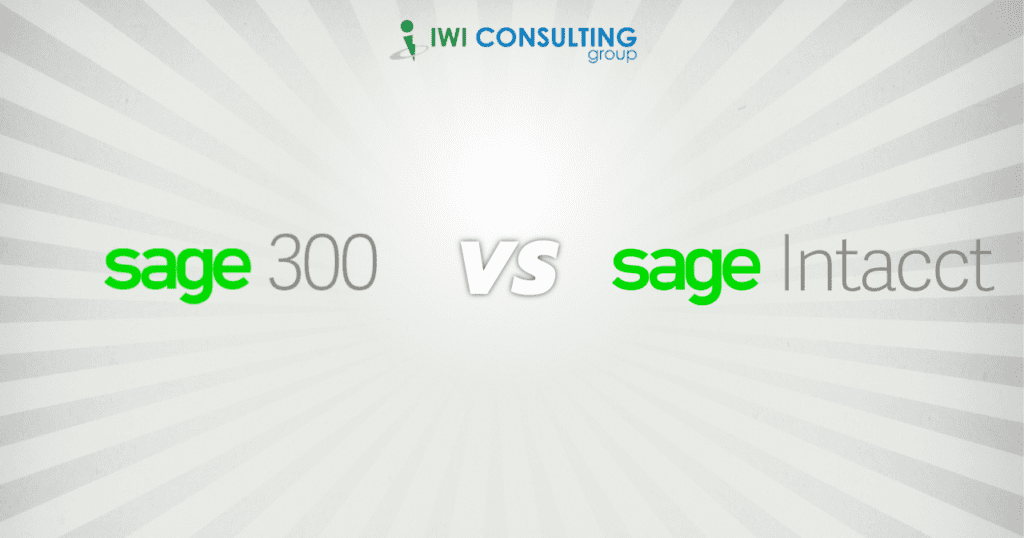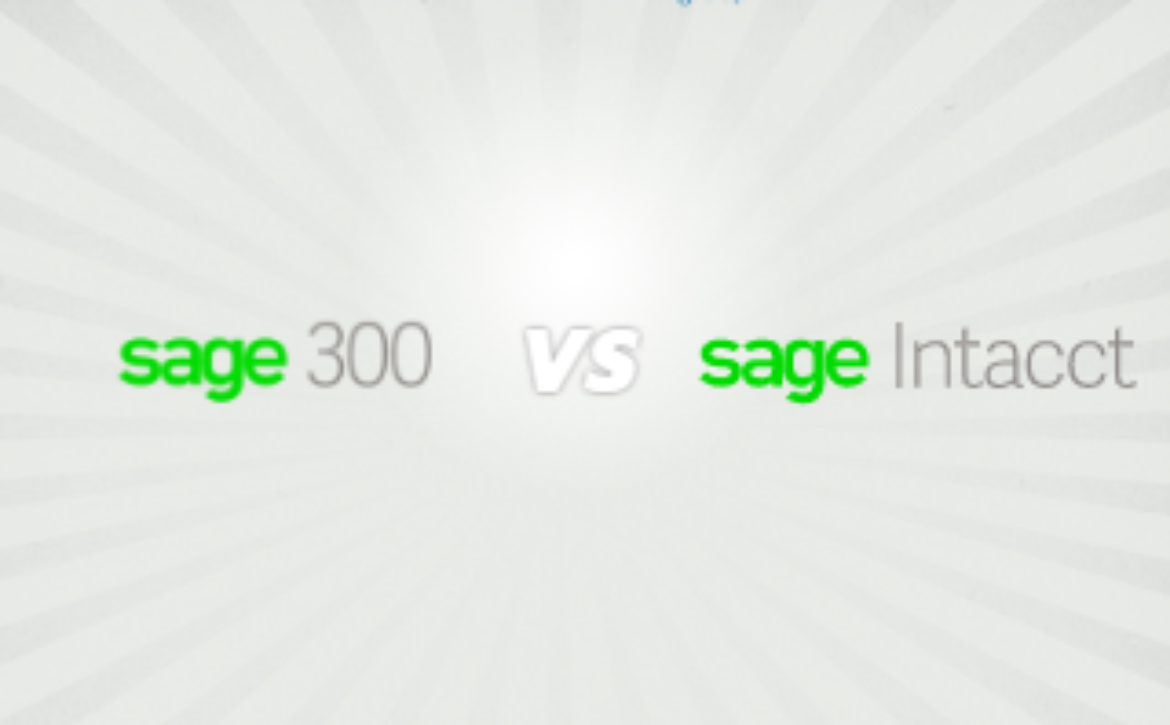Sage 300 vs. Sage Intacct: A Comprehensive Comparison of Two Accounting Software Solutions


In today’s competitive business landscape, choosing the right accounting software is crucial for streamlining financial processes and ensuring accuracy. Two prominent solutions in the market have garnered significant attention. This comprehensive comparison explores features, pricing, and advantages between Sage 300 vs. Sage Intacct.
Overview of Sage 300
Sage 300, formerly known as Accpac, is a popular accounting software designed for small to medium-sized businesses. It offers modules for core accounting, inventory management, and project tracking. Sage 300 provides a solid foundation for managing financial operations efficiently.
Overview of Sage Intacct
Sage Intacct is a cloud-based accounting software renowned for its robust features and scalability. Built for businesses of all sizes, it offers comprehensive financial management, advanced analytics, and industry-specific functionality. With its flexible architecture and seamless integrations, Sage Intacct empowers organizations to optimize their accounting processes and make data-driven decisions.
Pricing and Licensing: A Comparative Analysis
Regarding pricing, both Sage 300 and Sage Intacct adopt a subscription-based model. Sage 300 offers different pricing tiers based on the number of users and modules required. On the other hand, Sage Intacct tailors its pricing based on factors like the number of entities, the complexity of requirements, and the need for additional features. While Sage Intacct may appear more expensive up front, its advanced capabilities and scalability often provide a higher return on investment.
Deployment Options: Sage 300 vs. Sage Intacct
Sage 300 traditionally operates on-premises, requiring software installation and infrastructure maintenance. However, it also offers a cloud deployment option, enabling businesses to leverage the benefits of remote access and automatic software updates. In contrast, Sage Intacct is a cloud-native solution accessible from any device with an internet connection. The cloud-based architecture of Sage Intacct eliminates the need for IT infrastructure, reduces maintenance costs, and offers greater flexibility in remote work environments.
Key Features of Sage 300
Sage 300 offers a range of essential accounting features, including general ledger, accounts payable and receivable, and financial reporting. It provides inventory management capabilities, allowing businesses to track and optimize stock levels. Sage 300 also offers project accounting functionality, enabling project-based companies to manage costs, budgets, and resources effectively.
Key Features of Sage Intacct
Sage Intacct boasts a comprehensive suite of features designed to streamline financial operations. Its core accounting functionalities cover general ledger, accounts payable and receivable, cash management, and budgeting. In addition, Sage Intacct excels in advanced analytics, providing in-depth financial reporting, customizable dashboards, and real-time insights. The software also offers industry-specific functionality, such as multicurrency management, revenue recognition, and project accounting. These features make Sage Intacct a powerful tool for businesses with complex financial needs or in specific industries.
Sage 300 vs. Sage Intacct – Scalability and Flexibility
One of the critical advantages of Sage Intacct is its scalability. As businesses grow and evolve, their accounting software must accommodate increasing transaction volumes and expanding operations. Sage Intacct is built to scale effortlessly, allowing organizations to add users, modules, and entities without disrupting workflows or compromising performance. This scalability ensures that Sage Intacct remains a reliable and efficient solution as businesses expand their reach.
Furthermore, Sage Intacct offers flexibility in terms of customization and integrations. The software allows businesses to tailor their accounting processes to meet specific requirements, such as unique workflows or industry regulations. Integration capabilities with other business systems, such as CRM or payroll software, enable seamless data flow and eliminate manual data entry. This flexibility empowers businesses to create a cohesive ecosystem of related applications, enhancing efficiency and data accuracy.
User Interface and Ease of Use: A User-Friendly Experience
An intuitive user interface is crucial for maximizing productivity and minimizing training time. Sage 300 provides a user-friendly interface with navigation menus and familiar accounting workflows. However, some users may find the interface slightly dated or less intuitive than modern cloud-based solutions.
In contrast, Sage Intacct offers a modern, intuitive interface that prioritizes user experience. The software is designed with user-friendly features, such as customizable dashboards, drag-and-drop report builders, and streamlined workflows. The intuitive nature of Sage Intacct’s interface reduces the learning curve and empowers users to navigate the system quickly, increasing overall efficiency easily.
Integration Capabilities: Seamlessly Connecting Your Business
Integration capabilities are vital for ensuring data consistency and efficiency across different business systems. Sage 300 provides integration options with third-party applications, allowing businesses to connect their accounting software with other essential tools. However, the integration capabilities of Sage 300 may be more limited than Sage Intacct, which offers a robust integration ecosystem. Sage Intacct integrates seamlessly with various applications, such as CRM, payroll, and project management software, creating a unified ecosystem that streamlines data flow and eliminates manual data entry.
Reporting and Analytics: Empowering Data-Driven Decisions
Accurate and timely financial reporting is essential for informed decision-making. Sage 300 provides standard financial reports and allows users to create custom reports based on specific criteria. While these reporting capabilities are suitable for fundamental analysis, businesses with complex reporting needs may need more.
On the other hand, Sage Intacct offers advanced reporting and analytics functionalities. The software provides many pre-built reports, including balance sheets, income, and cash flow statements. Moreover, Sage Intacct’s dimensional reporting capabilities allow businesses to analyze financial data from different perspectives, providing deeper insights into performance, profitability, and trends. The advanced analytics of Sage Intacct empowers enterprises to make data-driven decisions and uncover valuable insights to drive growth.
Sage 300 vs. Sage Intacct – Industry-Specific Functionality
Different industries have unique accounting requirements and regulations. Sage 300 offers industry-specific features and modules, such as project accounting for professional services firms or inventory management for distribution companies. However, the range of industry-specific functionality in Sage 300 may be limited compared to Sage Intacct.
Sage Intacct recognizes the diverse needs of industries and provides specialized functionality for sectors such as nonprofit organizations, financial services, healthcare, and software/SaaS companies. These industry-specific features cater to businesses operating in these sectors’ unique accounting and reporting needs, ensuring compliance and efficiency.
Sage 300 vs. Sage Intacct – Customer Support and Training
Reliable customer support and comprehensive training resources are crucial for smooth software implementation and ongoing usage. Sage 300 offers customer support through phone and email and provides online resources such as knowledge bases and user forums. They also offer training options, including webinars and documentation, to help users get started with the software.
In comparison, Sage Intacct is known for its exceptional customer support. They provide dedicated customer success managers who offer personalized assistance and guidance throughout the implementation process. Sage Intacct’s support team is highly responsive and can be reached via phone, email, or chat. Additionally, they offer extensive training resources, including virtual and in-person training sessions, user guides, and a vibrant online community where users can connect and share best practices. Sage Intacct’s robust customer support and training options contribute to a positive user experience and ensure businesses can maximize the software’s potential.
Sage 300 vs. Sage Intacct – Implementation Process
The implementation process plays a crucial role in successfully adopting accounting software. Sage 300’s implementation process can vary depending on the complexity of the organization’s requirements. It typically involves a Sage implementation partner or consultant who helps configure the software and migrate data. While the implementation process can be tailored to meet specific needs, it may require more time and resources than Sage Intacct.
Sage Intacct takes pride in its streamlined implementation process. Their implementation team works closely with businesses to understand their unique requirements and ensure a smooth transition. With a well-defined implementation methodology and experienced consultants, Sage Intacct aims to minimize disruption and ensure a timely and efficient implementation. This approach allows businesses to quickly start leveraging the power of Sage Intacct without significant downtime or complexities.
Pros and Cons of Sage 300
Sage 300 offers several advantages, such as its long-standing reputation in the market, robust core accounting functionalities, and availability of industry-specific modules. It is a reliable choice for businesses with specific accounting needs and those who prefer an on-premises or hybrid deployment model. However, Sage 300 may be perceived as needing more advanced features, scalability, and modern user experience provided by cloud-native solutions like Sage Intacct.
Pros and Cons of Sage Intacct
Sage Intacct offers numerous advantages that set it apart as a leading accounting software solution. Its robust feature set, scalability, and cloud-native architecture make it an ideal choice for businesses with complex accounting requirements or those seeking flexibility and mobility. The intuitive user interface, advanced reporting, and analytics capabilities, extensive integration options, and industry-specific functionality make Sage Intacct a powerful tool for driving financial success. However, businesses with more specific accounting needs or those requiring on-premises deployments may find Sage Intacct’s cloud-based approach less suitable.
Sage 300 vs. Sage Intacct – Customer Reviews and Feedback
To gain insights into the experiences of actual users, it’s crucial to consider customer reviews and feedback. Sage 300 has received mixed reviews, with some users appreciating its reliability and robust accounting features, while others have expressed concerns about the user interface and limited scalability.
In contrast, Sage Intacct has garnered positive reviews from users who value its comprehensive functionality, scalability, and user-friendly interface. The software’s advanced reporting capabilities and excellent customer support are often highlighted as key strengths.
Final Verdict and Recommendation: Choosing the Right Solution
Both accounting software solutions offer distinct advantages in the battle of Sage 300 vs. Sage Intacct. Sage 300 is a reliable choice for businesses with basic accounting needs, industry-specific requirements, and a preference for on-premises or hybrid deployments. It provides a solid foundation for financial management but may need more advanced capabilities and modern user experience offered by cloud-based solutions like Sage Intacct.
On the other hand, Sage Intacct is a robust accounting software solution, particularly for businesses with complex requirements or those seeking scalability, flexibility, and advanced analytics. Its cloud-native architecture, intuitive user interface, extensive integration capabilities, and industry-specific functionality make it a preferred choice for organizations aiming to optimize their financial processes and make data-driven decisions.
When deciding between Sage 300 and Sage Intacct, assessing your organization’s needs, growth plans, and budget is crucial. Consider factors such as the complexity of your accounting requirements, the need for industry-specific functionality, scalability, integration capabilities, and user experience. Taking advantage of trial periods and demos and engaging with sales representatives can provide valuable insights and help you make an informed choice.
In conclusion, while Sage 300 has its merits, Sage Intacct shines through its advanced features, scalability, user-friendly interface, and comprehensive industry-specific solutions. As businesses evolve in a digitally transformed world, Sage Intacct offers the tools and capabilities to empower organizations to achieve financial success.
Remember, selecting the right accounting software is crucial for your business. By thoroughly evaluating your requirements and considering the strengths and limitations of Sage 300 and Sage Intacct, you can make an informed decision that aligns with your organization’s goals and sets the foundation for efficient financial management.
Why Choose IWI Consulting Group for Sage Software Solutions
The IWI Consulting Group is your trusted partner when selecting and implementing accounting software. As the largest Sage partner in Canada, we have extensive experience in assisting businesses of all sizes across various industries. Our team of experts can provide personalized guidance on choosing between Sage 300 vs. Sage Intacct, ensuring that you select the right solution to meet your unique requirements. We offer comprehensive training, implementation services, ongoing support, and customizations to optimize your software investment.


